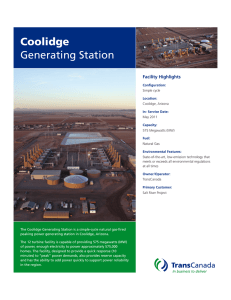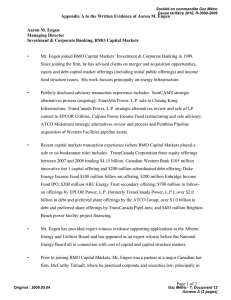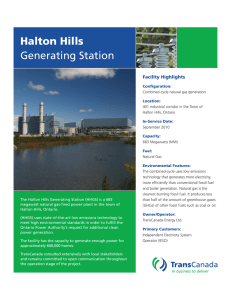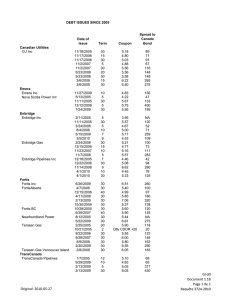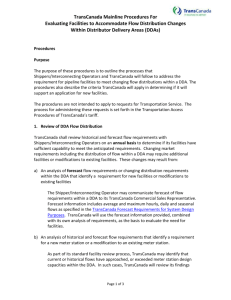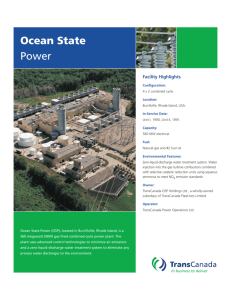Through safety programs and initiatives, we know our efforts are
advertisement
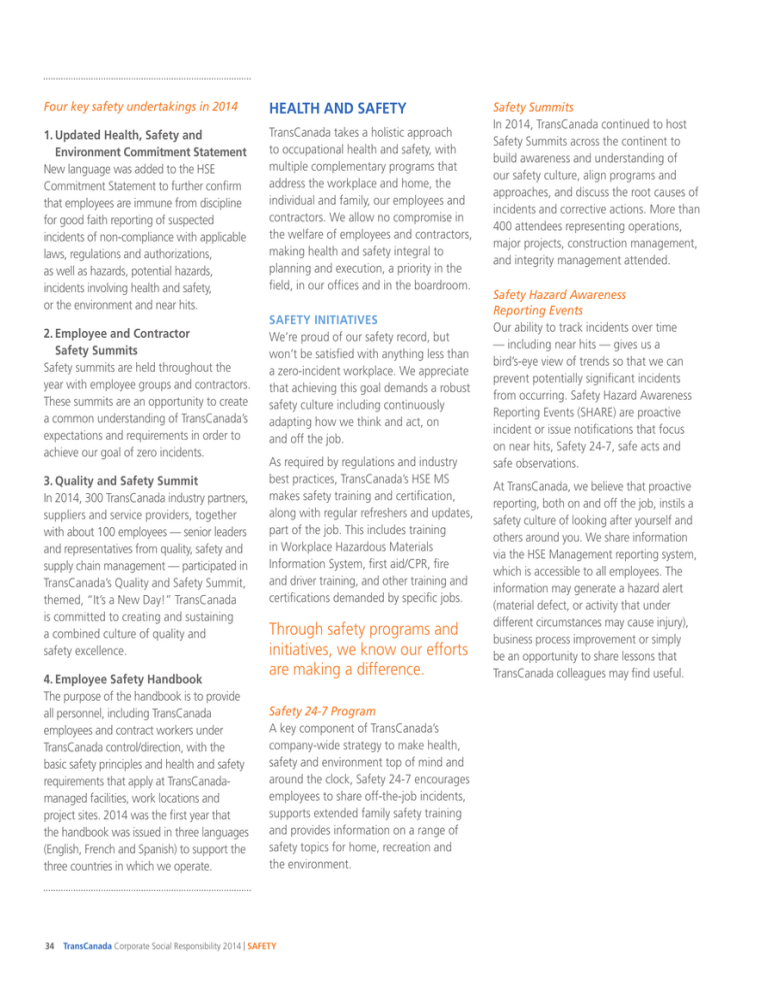
Four key safety undertakings in 2014 HEALTH AND SAFETY 1.Updated Health, Safety and Environment Commitment Statement New language was added to the HSE Commitment Statement to further confirm that employees are immune from discipline for good faith reporting of suspected incidents of non-compliance with applicable laws, regulations and authorizations, as well as hazards, potential hazards, incidents involving health and safety, or the environment and near hits. TransCanada takes a holistic approach to occupational health and safety, with multiple complementary programs that address the workplace and home, the individual and family, our employees and contractors. We allow no compromise in the welfare of employees and contractors, making health and safety integral to planning and execution, a priority in the field, in our offices and in the boardroom. 2.Employee and Contractor Safety Summits Safety summits are held throughout the year with employee groups and contractors. These summits are an opportunity to create a common understanding of TransCanada’s expectations and requirements in order to achieve our goal of zero incidents. 3.Quality and Safety Summit In 2014, 300 TransCanada industry partners, suppliers and service providers, together with about 100 employees — senior leaders and representatives from quality, safety and supply chain management — participated in TransCanada’s Quality and Safety Summit, themed, “It’s a New Day!” TransCanada is committed to creating and sustaining a combined culture of quality and safety excellence. 4.Employee Safety Handbook The purpose of the handbook is to provide all personnel, including TransCanada employees and contract workers under TransCanada control/direction, with the basic safety principles and health and safety requirements that apply at TransCanadamanaged facilities, work locations and project sites. 2014 was the first year that the handbook was issued in three languages (English, French and Spanish) to support the three countries in which we operate. 34 SAFETY INITIATIVES We’re proud of our safety record, but won’t be satisfied with anything less than a zero-incident workplace. We appreciate that achieving this goal demands a robust safety culture including continuously adapting how we think and act, on and off the job. As required by regulations and industry best practices, TransCanada’s HSE MS makes safety training and certification, along with regular refreshers and updates, part of the job. This includes training in Workplace Hazardous Materials Information System, first aid/CPR, fire and driver training, and other training and certifications demanded by specific jobs. Through safety programs and initiatives, we know our efforts are making a difference. Safety 24-7 Program A key component of TransCanada’s company-wide strategy to make health, safety and environment top of mind and around the clock, Safety 24-7 encourages employees to share off-the-job incidents, supports extended family safety training and provides information on a range of safety topics for home, recreation and the environment. TransCanada Corporate Social Responsibility 2014 | SAFETY Safety Summits In 2014, TransCanada continued to host Safety Summits across the continent to build awareness and understanding of our safety culture, align programs and approaches, and discuss the root causes of incidents and corrective actions. More than 400 attendees representing operations, major projects, construction management, and integrity management attended. Safety Hazard Awareness Reporting Events Our ability to track incidents over time — including near hits — gives us a bird’s-eye view of trends so that we can prevent potentially significant incidents from occurring. Safety Hazard Awareness Reporting Events (SHARE) are proactive incident or issue notifications that focus on near hits, Safety 24-7, safe acts and safe observations. At TransCanada, we believe that proactive reporting, both on and off the job, instils a safety culture of looking after yourself and others around you. We share information via the HSE Management reporting system, which is accessible to all employees. The information may generate a hazard alert (material defect, or activity that under different circumstances may cause injury), business process improvement or simply be an opportunity to share lessons that TransCanada colleagues may find useful. We’re proud of our safety record, but won’t be satisfied with anything less than a zero-incident workplace. We appreciate that achieving this goal demands a robust safety culture including continuously adapting how we think and act, on and off the job. 35 TransCanada Corporate Social Responsibility 2014 | SAFETY We use internal and external resources to focus on key areas of health promotion and illness prevention, short- and longterm disability management, employee and family assistance counselling programs, illness/injury absence reporting and health issue management. Our overall philosophy and approach to developing corporate safety targets is to set them such that we drive continuous improvement year after year. In 2014, safety performance for all of the safety 36 0.56 0.24 1.63 2.46 2.02 2.42 2.86 0.16 0.18 0.14 0.27 0.16 0.59 0.57 0.38 1.15 0.62 ‘08 ’09 ‘10 ’11 ‘12 ’13 ‘14 ‘08 ’09 ‘10 ’11 ‘12 ’13 ‘14 ‘08 ’09 ‘10 ’11 ‘12 ’13 ‘14 Vehicle incident rate High potential incidents rate 2.40 Total Recordable Case Rate (TRCR) refers to the number of recordable cases related to a common exposure base of 100 full-time employees. Recordable Cases are all work-related deaths and illnesses, and those work-related injuries which result in: loss of consciousness, restriction of work or motion, transfer to another job, or require medical treatment beyond first aid. (Bureau of Labor Statistics, Record Keeping Guidelines for Occupational Injuries and Illnesses) Away From Work Case Rate (AWCR) refers to an incident, which results in an injury or illness that prevents an employee from returning to work on the next scheduled shift. The number of away 0.47 0.76 1.05 0.91 ‘08 ’09 ‘10 ’11 ‘12 ’13 ‘14 1.21 2.51 2.70 2.77 2.42 ‘08 ’09 ‘10 ’11 ‘12 ’13 ‘14 metrics met or exceeded our corporate safety targets. TransCanada Corporate Social Responsibility 2014 | SAFETY (HIPO) 0.19 0.29 0.14 0.29 0.31 0.47 0.30 1.75 1.32 2.34 2.48 1.94 ‘08 ’09 ‘10 ’11 ‘12 ’13 ‘14 3.54 (VIFR) 3.41 (AWCR) 3.92 (TRCR) 1.02 Away from work case rate 3.14 Total recordable case rate • One SHARE event was reported for every 1,560 hours worked EMPLOYEE AND CONTRACTOR SAFETY Throughout TransCanada, employee and contractor safety is a priority. Safe, supportive workplace environments, procedures, training, tools and resources all work toward reducing injuries and incidents. (HIPO) CONTRACTOR SAFETY 2.88 • On average, 1.28 events were reported per 2,000 hours worked (based on combined employee and contractor SHARE counts and year-to-date hours reported) 0.50 ‘08 ’09 ‘10 ’11 ‘12 ’13 ‘14 1.07 • Employees and contractors reported 2,362 near hits, 65 per cent (1,541) of which were reported by contractors 1.04 • SHARE reports included identification and/or removal of hazards, such as removing potential tripping hazards, and employees and contractors adjusting their driving to fit proper weather and road conditions. High potential incidents rate (VIFR) 2.17 (AWCR) 1.26 (TRCR) Vehicle incident rate 0.38 Away from work case rate 2.58 Total recordable case rate 0.18 EMPLOYEE SAFETY 0.44 • Employees and contractors reported 20,899 proactive events involving near hits, safe acts, safety observations and Safety 24-7s (collectively SHARE reports) 0.40 In 2014, there were no employee fatalities. 0.55 2014 SHARE reporting provided a wealth of actionable information: ‘08 ’09 ‘10 ’11 ‘12 ’13 ‘14 from work cases, where the employee would have worked but could not because of occupational injury or illness, is related to a common exposure base of 100 fulltime workers. This performance indicator is often referred to as the lost time case rate. (Bureau of Labor Statistics, Record Keeping Guidelines for Occupational Injuries and Illnesses) Vehicle Incident Frequency Rate (VIFR) refers to the number of recordable vehicle incidents related to a common exposure base of 1,000,000 kilometres driven. A recordable vehicle incident is any incident (regardless of fault) involving a fleet or rental motor vehicle which results in an injury to any person or damage to any vehicle or property, unless the vehicle was safely and legally parked at the time of the incident. (American National Standards Institute [ANSI] standard D. 16.1 — 1989 “Manual on Classification of Motor Vehicle Traffic Accidents” — 5th Edition) High Potential Incidents Rate (HIPO) refers to incidents with a high potential to result in a serious, debilitating injury to the worker related to a common exposure base of 100 full-time employees. Examples of HIPO include, but are not limited to, high speed vehicle incidents, vehicle rollovers, high voltage or high pressure incidents, injuries to the head, falls from heights, etc. HEALTH PROGRAMS Employee and Family Assistance Program (EFAP) TransCanada’s EFAP is delivered by a network of professional advisors who are available day or night to give confidential assistance with concerns that affect our employee’s personal, family, work life or general well-being. In addition to traditional counselling services, the EFAP program also provides resources in areas such as legal, childcare, eldercare, nutrition, critical stress and addictions. Overall use of the EFAP decreased slightly in the U.S. from 4.74 per cent to 3.59 per cent and decreased in Canada from 20.98 per cent in 2013 to 18.97 per cent in 2014. TransCanada’s EFAP Program usage within Canada and the U.S. is comparable to industry utilization. Use of the EFAP program by expatriates in Mexico increased significantly from 5.0 per cent in 2013 to 19.05 per cent in 2014 as a result of increased communication and awareness of the resources. Health Services and management will continue to encourage the use of the EFAP, particularly with a focus in the U.S. where utilization lags, as the EFAP can be a significant means of preventing or mitigating certain sources of illness (stress, depression, etc.). Alcohol and Drug Program Throughout the year, we conducted Department of Transportation (DOT) random testing of the U.S. employees holding safety sensitive roles. We successfully met our annual 25 per cent testing rate required by the DOT. There were zero non-compliant results for random tests in 2014, a strong performance compared to industry performance of 1 to 2 per cent positive random tests per year. In 2014, we conducted 295 preemployment tests, resulting in two non-compliant test results. TransCanada conducted three post incident tests, all of which were negative for alcohol or drugs. One reasonable cause test was completed in 2014 in which the result was not in accordance with the company’s alcohol and drug policy. We continue to administer a pre-site access program on construction sites within British Columbia (B.C.), Alberta, Saskatchewan and Manitoba. The pre-site access program is for employees accessing a TransCanada construction site, which is defined by company criteria and provincial regulations. There were 54 site access tests completed and zero non-compliant site access tests in 2014. In 2014, we began providing increased training to our leaders on testing for reasonable cause and post-incident requirements. This will continue into 2015 and, due to increased training and awareness, TransCanada may see a possible increase in ad hoc testing activity in the future. Active Living Program TransCanada’s Active Living Program is a company-wide program designed to encourage our employees and contractors to increase the amount of physical activity in their everyday lives. Proper nutrition and physical activity are important components of a healthy lifestyle. Making small changes, or continuing an established healthy routine, will help lead to an improved overall well-being. Benefits to an active lifestyle include more energy, reduced stress, stronger muscles and bones, and a lower risk of health problems such as heart disease, stroke and diabetes. An Active Living website was developed and a total of 1,320 employees from across the company participated in this program in 2014 — a 31 per cent increase over 2013. More than 600 employees participated in a three-week pedometer challenge with the goal of completing 10,000 steps per day. The total number of steps logged was equivalent to 48,280 km (30,000 miles). The response to the challenge was overwhelmingly positive and additional challenges will be incorporated into the Active Living Program in 2015. Health Services continues to develop the Active Living Toolkit to assist ‘wellness champions’ across the company to develop and administer a physical activity or health challenge. This now includes two challenges: the “Healthy Points Challenge” which is aimed at increasing health decisions on a daily basis through a competitive points-based system and the “Maintain Don’t Gain Challenge,” which was designed to incorporate nutrition, healthy decisions, increased physical activity, and enhanced stress management into the daily lives of our employees during the holiday season. We will continue to develop and improve each of these challenges throughout 2015. TransCanada Corporate Social Responsibility 2014 | SAFETY 37 H E A LT H Y L I V I N G — I N AC T I O N From August 26 to September 1, 2014, the world came to Edmonton, Alberta, for the TransCanada Corp. World Triathlon Grand Final. The event officially closed the 25th annual World Triathlon Series, which included eight triathlon races worldwide. In the months leading up to the event, the International Triathlon Union (ITU), local Ergonomics Program Ergonomics is an applied science concerned with the human need considered in designing tools and equipment so the interaction between the person and their work environment is effective and safe. TransCanada’s office ergonomics programs continued to be utilized within the Calgary and Houston offices. There were 224 assessments, and 11 followup assessments completed in Calgary and 42 assessments completed in Houston in 2014. The number of assessments in Calgary has dropped slightly; however, the assessments in Houston have almost doubled due to increased awareness and a building move. The number of requests is anticipated to increase further in 2015 with increased awareness of the program both within the office and field environments. 38 organizing committee, community partners, government and corporate sponsors worked together to ensure the event was an epic experience for athletes, coaches, community members and participants. During the event, employees of corporate sponsors, including TransCanada as title sponsor, had a chance to race on an elite level course with their colleagues. TransCanada had the largest team of all of the sponsors with 32 participating employees. “We have a great Active Living Program at TransCanada that encourages all of us to be healthy and stay active in whatever sport we enjoy,” says Rick Coutts, As of January 2014, ErgoRisk, our ergonomics service provider, has been completing our new hire ergonomic evaluations. It completed 1,441 spot checks for new hires and employees who moved locations. This early emphasis on correct workstation setup and guidance on how to use the workstation properly is expected to reduce the potential negative effects of pain syndromes that arise from poor postures. It is anticipated that employees will experience these issues less frequently, and the long-term goal is to mitigate days lost. This proactive approach should result in a decrease in the number of full assessments completed in Calgary in 2015. Lifestyle Management and Disease Prevention In 2014, Health Services conducted face-to-face educational sessions on the TransCanada Corporate Social Responsibility 2014 | SAFETY corporate racer and vice-president of construction quality and project management at TransCanada. “I was very happy to see us step up to support the ITU championships, and I was just really excited to be there and to be able to compete.” The TransCanada triathlon team did a fantastic job, as did all the racers and participants in the event. The International Triathlon Union has just released its 2015 schedule where, once again, the world’s elite triathletes will compete for the coveted title of world triathlon champion. TransCanada has supported sport, culture and economic growth across North America for more than 60 years. topic of Mental Health Resiliency. These sessions, entitled Thriving Under Pressure: Resiliency at Work, were developed with the assistance of our EFAP provider, and focused on assisting employees with finding positive ways to cope with stress, change and adversity. The presentation was built around the premise that, although we are often unable to control the changes going on around us, we are responsible for how we choose to respond to those changes. The focus of the presentation was on choosing a positive attitude about change and allowing that to impact actions. In addition, Health Services facilitated approximately 55 awareness presentations (in-person or WebEx) on a variety of health, lifestyle and industrial hygiene topics. The health education awareness topics are selected as a result of both internal health trending statistics and industry focus points.
